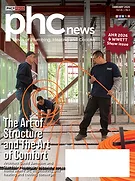Instant hot water at the turn of a tap is a luxury that many in developed countries take for granted, with little thought spared to exactly how it is available on the 50th floor.
For decades, this feat of engineering has resulted from the many hours spent manually balancing and rebalancing domestic hot water recirculation systems, often performed several times to accommodate flow as system demand evolved. While effective enough in principle, manual balancing flounders in practice, with inflated labor costs and inflexibility in the face of usage variations.
To conquer the challenges inherent to traditional manual balancing methods, ThermOmegaTech invented the CircuitSolver® thermostatic balancing valve (www.circuitsolver.com). It automatically balances the DHWS by adjusting flow through the system to maintain a set temperature at the end of each supply branch, eliminating the need for manual balancing while ensuring instant hot water delivery to each fixture and accommodating flow to meet demand variations.
Since its debut in 2012, the CircuitSolver has been installed in thousands of domestic hot water recirculation systems throughout the United States and Canada.
ThermOmegaTech caught up with three plumbing engineers for their opinion on the valve: Joper Tupas, PE, CPD, from the Murray Co. Engineering Department, Rancho Dominguez, Calif.; Rick Sawyer from BMA Mechanical+, San Luis Obispo, Calif.; and Scott Fawkes and Michael Washburn from Architectural Resources Inc., New York, N.Y.
ThermOmegaTech: Why do you choose to specify CircuitSolver?
Joper Tupas: The benefits: ease of installation and auto-balancing of the system.
Rick Sawyer: When we were first introduced to the product, we saw the “set it and forget it” usefulness that appeared far superior to manually adjusting flow setters.
Scott Fawkes and Michael Washburn: ARI specifies CircuitSolvers for projects with multiple branch lines for circulating hot water systems to eliminate the need for multiple balancing devices that may come out of adjustment over time.
TOT: How long have you been specifying the valve?
JT: For about three years now; we’ve installed it in a few high-rise building projects.
TOT: Do you have a ‘go-to’ configuration that you specify most often?
RS: Yes; CSUAS complete with strainer and shut-off valves. I didn’t even need to look up the model as I have it memorized by now. Why not install the best all at the same time?
TOT: Can you name any large projects of yours that have used these thermostatic balancing valves?
JT: The New Century Plaza Residential Towers uses 296 3/4-inch CircuitSolver Union Assemblies at 120 F.
We specified 1/2-inch CircuitSolver Union Assembly strainers at the Academy Square Residential Tower at 120 F; 29 are installed.
And the UCLA Lot 15 project has 45 of the 3/4-inch CircuitSolver Union Assemblies at 120 F.
RS: The largest project I’ve personally designed is the San Luis Obispo Housing Authority project, called Iron Works. The project consisted of two three-story low-income housing apartments with a total of 46 units.
Another project called Meadow Creek Assisted Living consisted of two buildings. Building A was an assisted living facility with 70 units; memory care on the basement level, and assisted living on the ground level and second floor. Building B (16 units) was an independent living facility with amenities on the basement level, and living units on the ground and second floors.
Each building had its own water heating equipment. Six CircuitSolvers were installed in Building A. Building B was similar, with a loop on each floor and three of the valves installed.
ST/MW: One particular project was a retrofit for an existing system. The apartment-type building had many vertical hot water risers (approximately 26) that were not seeing flow due to lack of balancing over the years. The building owner is extremely happy with the results.
TOT: What do you think is the main quantifiable benefit of using this thermostatic balancing valve over a manual balancing valve?
JT: Installation, balancing and commissioning time.
RS: There seems to be a whole lot less time required to balance a system as there is no balancing.
ST/MW: Once the valve is in place, it appears that you will not require any adjusting or modifications in the future.
TOT: On a scale of 1-10 (with 10 being the highest), how satisfied are you with CircuitSolver offerings?
JT: 10; they are easy to select, and their options on pre-piped assembly are great.
RS: 10. Why? No callbacks. We specify the product, the contractor installs it, and we have yet to hear any negative feedback. You never hear when a product works as well as it’s supposed to, but you most certainly hear when something is wrong.
TOT: Do you think we will see more of a market shift towards the use of automatic balancing valves?
ST/MW: Yes, mainly because of the non-need for continual maintenance or chance that the balancing can be set out of adjustment inadvertently by the building owner.





